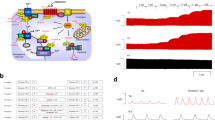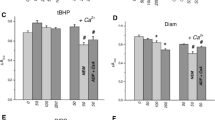Summary
The influence of N-ethylmaleimide and trypsin was studied on stimulatory and inhibitory regulations of the hamster adipocyte adenylate cyclase. Treatment of intact adipocytes or adipocyte ghosts with N-ethylmaleimide decreased basal and forskolin-stimulated adenylate cyclase activities. In the pretreated membrane preparations, inhibition of the enzyme by GTP and by stable GTP analogues was abolished. Concomitantly, activation of the adenylate cyclase by NaCl and its inhibition by the antilipolytic agents, prostaglandin E1 and nicotinic acid, were obliterated. In contrast, adenylate cyclase stimulation by ACTH and stable GTP analogues was not impaired but rather increased. Similarly, the NaCl-induced attenuation of the ACTH-stimulated enzyme activity was increased by the N-ethylmaleimide treatment. Limited proteolysis of hamster adipocyte ghosts with trypsin also obliterated GTP and prostaglandin E1-induced inhibitions and NaCl-induced activation of the adenylate cyclase. In contrast, adenylate cyclase activity stimulated by isoproterenol was increased after trypsin treatment. The data suggest that the activity of the adenylate cyclase is regulated via two distinct guanine nucleotide sites and that treatment with N-ethylmaleimide and limited proteolysis with trypsin functionally eliminates the regulatory site mediating adenylate cyclase inhibition, leading to a state where the enzyme activity is regulated only via the stimulatory site. The differential effects of these treatments on NaCl-induced activation and attenuation of the adenylate cyclase suggest that sodium acts on both regulatory sites in an inhibitory manner, and that by the functional elimination of the inhibitory site, only the sodium-induced attenuation of the adenylate cyclase via the stimulatory site is observed.
Similar content being viewed by others
References
Aktories K, Jakobs KH (1981) Epinephrine inhibits adenylate cyclase and stimulates a GTPase in human platelet membranes via α-adrenoceptors. FEBS Lett 130:235–238
Aktories K, Schultz G, Jakobs KH (1979) Inhibition of hamster fat cell adenylate cyclase by prostaglandin E1 and epinephrine: Requirement for GTP and sodium ions. FEBS Lett 107:100–104
Aktories K, Schultz G, Jakobs KH (1980) Regulation of adenylate cyclase activity in hamster adipocytes: Inhibition by prostaglandins, α-adrenergic agonists and nicotinic acid. Naunyn-Schmiedeberg's Arch Pharmacol 312:167–173
Aktories K, Schultz G, Jakobs KH (1981a) Na+ amplifies adenosine receptor-mediated inhibition of adipocyte adenylate cyclase. Eur J Pharmacol 71:157–160
Aktories K, Schultz G, Jakobs KH (1981b) The hamster adipocyte adenylate cyclase system. II. Regulation of enzyme stimulation and inhibition by monovalent cations. Biochim Biophys Acta 676: 59–67
Aktories K, Schultz G, Jakobs KH (1982a) Stimulation of a low K m GTPase by inhibitors of adipocyte adenylate cyclase. Mol Pharmacol 21:336–342
Aktories K, Schultz G, Jakobs KH (1982b) Cholera toxin does not impair hormonal inhibition of adenylate cyclase and concomitant stimulation of a GTPase in adipocyte membranes. Biochim Biophys Acta 719:58–64
Aktories K, Schultz G, Jakobs KH (1982c) Cholera toxin inhibits protaglandin E1 but not adrenaline-induced stimulation of GTP hydrolysis in human platelet membranes. FEBS Lett 146:65–68
Cassel D, Selinger Z (1977) Mechanism of adenylate cyclase activation by cholera toxin: Inhibition of GTP hydrolysis at the regulatory site. Proc Natl Acad Sci USA 74:3307–3311
Cassel D, Selinger Z (1978) Mechanism of adenylate cyclase activation through the β-adrenergic receptor: Catecholamine-induced displacement of bound GDP by GTP. Proc Natl Acad Sci USA 75:4155–4159
Cooper DMF (1982) Bimodal regulation of adenylate cyclase. FEBS Lett 138:157–163
Hanski E, Sternweis PC, Northup JK, Dromerick AW, Gilman AG (1981) The regulatory component of adenylate cyclase. Purification and properties of the turkey erythrocyte protein. J Biol Chem 256:12911–12919
Harden TK, Scheer AG, Smith MH (1982) Differential modification of the interaction of cardiac muscarinic cholinergic and beta-adrenergic receptors with a guanine nucleotide binding component(s). Mol Pharmacol 21:570–580
Jakobs KH (1979) Inhibition of adenylate cyclase by hormones and neurotransmitters. Mol Cell Endocrinol 16:147–156
Jakobs KH, Saur W, Schultz G (1976) Reduction of adenylate cyclase activity in lysates of human platelets by the alpha-adrenergic component of epinephrine. J Cyclic Nucl Res 2:381–392
Jakobs KH, Aktories K, Schultz G (1982a) Inhibitory coupling of hormone and neurotrasmitter receptors to adenylate cyclase. J Receptor Res (in press)
Jakobs KH, Lasch P, Aktories K, Minuth M, Schultz G (1982b) Uncoupling of α-adrenoceptor-mediated inhibition of human platelet adenylate cyclate cyclase. J Biol Chem 257:2829–2833
Koski G, Klee WA (1981) Opiates inhibit adenylate cyclase by stimulating GTP hydrolysis. Proc Natl Acad Sci USA 78:4185–4189
Lowry OH, Rosebrough NJ, Farr AL, Randall RJ (1951) Protein measurement with the Folin phenol reagent. J Biol Chem 193: 265–275
Northup JK, Sternweis PC, Smigel MD, Schleifer LS, Ross EM, Gilman AG (1980) Purification of the regulatory component of adenylate cyclase. Proc Natl Acad Sci USA 77:6516–6520
Rodbell M (1980) The role of hormone receptors and GTP-regulatory proteins in membrane transduction. Nature 284:17–22
Ross EM, Gilman AG (1980) Biochemical propertics of hormone-sensitive adenylate cyclase. Ann Rev Biochem 49:533–564
Seamon KB, Daly JW (1981) Forskolin: A unique diterpene activator of cyclic AMP-generating systems. J Cyclic Nucl Res 7:201–224
Steer ML, Wood A (1981) Inhibitory effects of sodium and other monovalent cations on human platelet adenylate cyclase. J Biol Chem 256:9990–9993
Sternweis PC, Northup JK, Smigel MD, Gilman AG (1981) The regulatory component of adenylate cyclase. Purification and properties. J Biol Chem 256:11517–11526
Stiles GL, Lefkowitz RJ (1982) Hormone-sensitive adenylate cyclase. Delineation of a trypsin-sensitive site in the pathway of receptor-mediated inhibition. J Biol Chem 257:6287–6291
Verrier B, Chambard M, Mauchamp J (1982) Specific inhibition by Na+ of TSH-stimulated thyroid cell adenylate cyclase. FEBS Lett 138:303–306
Walseth TF, Johnson RA (1979) The enzymatic preparation of [α-32P]-nucleoside triphosphates, cyclic [32P]AMP, and cyclic [32P]GMP. Biochim Biophys Acta 562:11–31
Yamamura H, Lad PM, Rodbell M (1977) GTP stimulates and inhibits adenylate cyclase in fat cell membranes through distinct regulatory processes. J Biol Chem 252:7964–7966
Author information
Authors and Affiliations
Rights and permissions
About this article
Cite this article
Aktories, K., Schultz, G. & Jakobs, K.H. Inactivation of the guanine nucleotide regulatory site mediating inhibition of the adenylate cyclase in hamster adipocytes. Naunyn-Schmiedeberg's Arch. Pharmacol. 321, 247–252 (1982). https://doi.org/10.1007/BF00498508
Received:
Accepted:
Issue Date:
DOI: https://doi.org/10.1007/BF00498508




